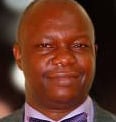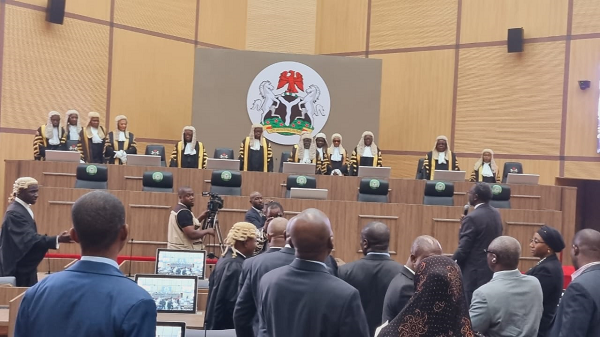I have read many biographies and autobiographies. Seldom have narratives of the life story of any individual contained in them mesmerised me as the narratives of the biography, Comrade Olusegun Abatan: A Prisoner of Conscience. An admixture of grief, pain, struggle and determination to survive the pangs of life and become a champion of the vicissitudes of life, this book is a riveting account of the legendary fight by this activist unionist to live and become somebody in life. It is a chronology of his struggle to contribute to the world he found himself.
Divided into 18 chapters, excluding the preliminary pages, the reader will encounter how a man walked with Providence to live and become a champion of his chosen life endeavour.
The reader is first taken through the ancestral roots of the subject of the biography in the Alapinni compound of Oyo in Oyo state and how his paternal and maternal families were of commendable pedigree. From here, the reader will get to find out that, by reading this biography, they are getting the price of two. Masterfully told, the author, Dr Olatunde Amusat, weaves a narrative that knots history into the present like a wood carver or a weaver of tapestry. He carved today from and with yesterday to make an enchanting craft. So, while reading the life story of the man who grew to be a unionist par excellence, you will also be told ancillary narratives of the history of Yorubaland and Nigeria in general.
For instance, in the first chapter, entitled Ayelaagbe’s Family Roots, you will also be apprised of a piece of history of Yorubaland. You will be availed with the 19th-century history of the Yoruba Empire of Oyo and how the Fulani destroyed a very essential corpus of an empire that grew up to Dahomey, now Benin Republic. You will also learn of some of the kings of Oyo, the creation of the emirate of Ilorin, Oranmiyan, the first Alaafin of Oyo, Ajaka and the very powerful legislative system called the Oyomesi. Those who hitherto didn’t know of how Oyo Ile was abandoned in 1835, leading to splinters of its indigenes finding an anchor in many other towns of Yorubaland, are told with ease as someone weaving a tapestry in this biography. What is the position of the Oyo Ile now? This biography will provide us with how this ruined empire headquarters morphed from its ruing into becoming a game reserve and later, a National Park.
Advertisement
Chapter two, aptly entitled The Starting Point, gives you a vivid dip into the poetries of Professors Wole Soyinka and John Pepper-Clark. Both literary giants had written evergreen poems entitled Abiku. While both poems make the subject of their literary engagements the poetic narrative of a child who dies severally, only to return to life many times, both poems presented in different ways to give alternate meanings to the story of life and death. They also contain nature imageries and beliefs in incarnation. In their discussion of the Abiku, an infant child who dies and is buried before reaching puberty, they seem to tell the story of Comrade Olusegun Ayelaagbe Abatan’s mother, Titilola, as told in this biography. Titilola, within 20 years of marriage, gave birth to nine children for her husband Morounranti and all of them died in their infancy. Perhaps what the author didn’t tell us, or what the subject of the biography, Ayelaagbe didn’t tell the author, the reader can find it in Soyinka’s Abiku.
In its going and coming several seasons, Soyinka told us that the Abiku will come again when “the snail is burnt in his shell,/Whet the heated fragment, brand me/Deeply on the breast.” This indicates the several incisions made on the body of the Abiku child, and how, despite these scarifications, the Abiku will return when “the ground is wet with mourning/White dew suckles flesh-birds.” These last lines indicate the several rivulets of tears Ayelaagbe’s mother must have shed on the torment she went through from her coming and departing children. Is it the torment of being referred to as an agan that we want to talk about? Or the several nights when she would wet her pillow crying? However, on July 2, 1954, the boy Ayelaagbe arrived to stay. Only Baba Morounranti and Mama Titilola Abatan could tell the world the spiritual links of Ayelaagbe to the spirit world and his interminable birth that were broken forever on that day.
This chapter also dwells on the sudden paralysis suffered by Ayelaagbe at the age of four. The author volunteered how it happened. He said: I was “crossing my mother’s room to another place when I slipped on a bunch of broom. I fell, and right there, I could neither walk nor sit properly again. I had to be propped up to eat and drink”. This tragedy was programmed to dim the glory and the existential interventions in the lives of many suffering pensioners he was destined to provide. Providence, at this period, was there for the pensioners of many decades to come. Though we were never told in the biography what could be responsible for the unexplained paralysis, a seemingly innocuous statement in the book which is demonstrative of the continuation of a spiritual battle against the young child, came from Ayelaagbe himself. As the throbs got unbearable, the young Ayelaagbe was quoted in the book to have one day called his mother three times and instructed her to take him to Mama Larondo (his aunt’s church) in Irefin and how, one day, his half-sister carried the five-year-old child to Irefin where, at the age of six, he began to recover how to walk again.
Advertisement
While Chapter three of the book drills into the precocious little boy in the high school at Ibadan Christ Apostolic Grammar School (ICAGS), Aperin-Oniyere, Ibadan, from 1967 to 1971, it also announces the calamity that befell him by the sudden death of his father on November 5, 1969. It was two years into the Civil War. Appropriately put, the author compared Ayelaagbe’s father’s tragic death at that point in his life to the strike of a thunderbolt.
As a path the author had chosen to sustain a connection between the reader and their history, the book at this point also narrates some occurrences during the Nigerian civil war which fell at the time of Ayelaagbe’s entrance into high school. One was the heroism of the fighters of that war like the Third Marine Commandos team under the command of Brigadier Benjamin Adekunle (The Black Scorpion) and the bravery exhibited by Generals Alani Akinrinade, Alabi Isama, Isaac Adaka Boro and others.
Chapter four was a discussion that was necessary to establish Abatan’s first taste of detention as a unionist at the Cocoa Research Institute of Nigeria, Ibadan where he worked. It dovetails into the next chapter and consistently sustains the trove of a unionist made to suffer for standing up in defence of his co-workers.
In the subsequent chapter, the discussion centred around Abatan, now an Agricultural Science teacher at Lagelu Grammar School and Bishop Phillips Academy, who will make the children of today salivate for what they lost in school agricultural programmes. As a teacher, Abatan not only impacted theoretical knowledge, he also practicalised it by cultivating acres of farmland that not only made his schools self-sustaining but proceeds of which were sold to their communities.
Advertisement
Chapters seven and eight can be referred to as the formative processes for the ultimate appearance of Comrade Abatan on the centre stage of activism. The story begins with his baptism during the Nigerian Union of Pensioners (NUP) Oyo State branch’s protest in 2006. That protest was NUP leadership’s wake from its lethargy. The NUP then chose to protest against the perceived government’s insensitivity in owing pension arrears. The protest, which was taken to the front of the Governor’s Office, Agodi, had Governor Rashidi Ladoja coming out from his convoy of cars to listen to the protesters. Abatan learnt a vital lesson from this protest. It was that, in the face of trampling on rights, a unionist must be determined, fearless and stand with the people. His short stint with the idea of a Pensioners’ Welfare Association taught him another vital lesson that an activist must beware of wolves within who are dressed in sheep’s clothing. All the above were to strengthen and energise the comrades for the battle to come against governors Ladoja, Adebayo Alao-Akala and Abiola Ajimobi.
In November 2012, information got to me that a famous son of Oyo state was lying critically ill at the University College Hospital, Ibadan. Samuel Ojebode, famously known as Sam Ojebode, played for the darling Southwest team of Oyo state, the Shooting Stars. He and his team members led the club to win the 1976 African Cup Winners’ Cup even as he proceeded to wear the green-white-green jersey and as captaincy of the Nigerian national team in three matches of the 1976 African Cup of Nations. Ojebode also appeared in four FIFA World Cup qualifying matches. In the soccer annals of Nigeria, he was considered an accomplished footballer of note who, alongside other famous players like Segun Odegbami, Kunle Awesu, Felix Owolabi, Mudasiru Lawal, Best Ogedegbe, Phillips Boamah and others won the prestigious 1976 first African Continental Cup. It was this man who was ill at the UCH.
In the company of my colleague, the Special Adviser on Protocol, Toye Arulogun, we briefed the Chief of Staff to Governor Abiola Ajimobi on the development. Promptly, the governor was scheduled to pay a visit to the South-West 3 ward of UCH where Ojebode was on admission. The governor wished Ojebode a quick recovery and made arrangements for the state government to intervene in defraying the cost of his treatment in the hospital. Unfortunately, Ojebode passed on a few months later.
However, upon getting downstairs, someone on the entourage told the team that he saw Comrade Olusegun Abatan lying ill on one of the beds in the hospital. This information was passed to the Chief of Staff, then Dr. Adeolu Akande, who promptly conveyed it to the governor. A very compassionate man, Ajimobi, who had descended the stairs of the ward, had to climb back to the ward to see Abatan. After conferring with the medical team at the ward, the governor conveyed the state government’s readiness to pay the cost of the NUP Secretary’s treatment in India.
Advertisement
The above story and the narrative of how, as he drove to a screening exercise called I Am Alive of the Federal Government Pensioners, Comrade Abatan suddenly had a heart attack, dominate chapters nine and 10 of the book. It also reveals that activism, fighting for his and others’ rights, are the battles of the life of Abatan. Even on his sick bed at UCH and the Madras Medical Mission, Chennai, India, Abatan was still a fighter for rights.
Chapters 11 and 12 contain the activist’s paradigmatic shift of approach to fighting for the rights of pensioners. Here, we are intimated of how Abatan restrategised the age-long pensioners’ agitation for their rights. He did this by shifting from barefaced confrontation with authority to the courts. It also marks his clash with Governor Ajimobi.
Advertisement
Chapters 13 and 14 herald good tidings for Oyo state pensioners. Abatan narrates here, through the book’s author, how the senior citizens found favour in the sight of a government that is pensioners-friendly and which, under the headship of Governor Seyi Makinde, has become the most favourable to pensioners. In chapter 15 of the book titled Oluwasegun Ayelaagbe Abatan – Navigating the Dangerous Minefields of Activism and Unionism, the reader is taken through the critical but incisive decisions that had to be taken by the union under Abatan’s secretaryship and how, for those interventions, the union would have been railroaded into a cul-de-sac.
As that English saying goes, all work and no play makes Jack a dull boy. For Comrade Abatan, it seemed that even activism was susceptible to the arrows of Cupid. And, as the Holy Writ submits that he who finds a good wife finds a good thing, Chapter 16 dissects the love chemistry between Abatan and the woman who later became the flesh of his flesh and bone of his bones. Then Miss Olivia Amaechi, now Mrs Chioma Abatan, Abatan found a life soulmate. The chance meeting, with the benefit of hindsight, is indicative of Miss Amaechi’s surname – who knows tomorrow. That tomorrow is today that has given birth to a happy family blessed with wonderful children.
Advertisement
The final chapter, 17, is a collation of the innumerable catalogue of Abatan’s contributions and awards as secretary of the NUP, Oyo state. It also contains several tributes by organisations and individuals who value his maverick contributions to activism on behalf of the senior citizens of the state.
Critique
Advertisement
This book is a great addition to biographies and autobiographies of men and women who contributed to the struggle to make things better in the world. Adorned in beautiful blue and grey colours, the book is an aesthetic wonder to behold. The lettering is also adult-friendly. In Nigeria where government runners have gone into somnolence, forgetting that they are with the suffering people of Nigeria, this book is a catalogue of a man’s worthy interventions on behalf of the collective.
For anyone passing through travails or one who is down, the book should be a manual on how never to say Never. Examples in this regard in this book are that of the author’s mother, Mama Marian Titilola, nee Ojewale and her son, Ayelaagbe Olusegun Abatan. At moments when their abilities to fructify, and to live, must have been written off, the two became cats with nine lives.
The book, Comrade Olusegun Abatan: A Prisoner of Conscience, must be commended for its skilful deployment of history to fortify the essence of the biography. This skill enriches the work and makes it a desirable object to be sought after by not only those interested in the strides of great men but also those who want to have an understanding of their past and recent history.
However, like every work of art, the book is not without its limitations. It could do with stronger editing. Nevertheless, this did not dim the shining nuggets hidden in this book. I recommend it to youths who desire to make a success of their endeavours and the society at large for a study of how their activists blend personal privations with fights for the collective.
Views expressed by contributors are strictly personal and not of TheCable.









